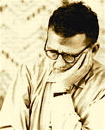
Shostakovich began his Symphony No. 15 while convalescing in a hospital. The first performance was by the USSR Radio Symphony conducted by Maxim Shostakovich on January 8, 1972. It's one of the stranger works in the composer's canon, and surprised early listeners with its repeated quotes of the famous theme from Rossini's William Tell and the "Fate" motif and "Siegfried's Funeral March" from Wagner's Ring cycle, as well as references to many of Shostakovich's previous symphonies. These deliberately blatant borrowings have never been definitively explained, but to some extent the composer knew this would be a valedictory work, so some form of autobiography has been assumed by later commentators and analysts, who regularly call it "puzzling" and "enigmatic."
The composer's liner notes to the first recording, by his son Maxim and issued on the official Soviet record label Melodiya, say the first movement depicts toys coming to life at night in a toy shop. No such light-hearted story could distract anyone but the most ignorant Soviet bureaucrat from hearing what a soul-shattering work this is as a whole, however. Here is my alternative, perhaps fanciful, yet plausible alternative interpretation of this movement and the work as a whole. (I wrote this at the beginning of the decade for CDNOW.com, but that's in the crapper and I want this theory out in the world.) The musical quote in the first movement which has so long left analysts scratching their heads is the William Tell tune. In the West, this seems banal thanks to its use as the Lone Ranger's radio theme and subsequent appropriations of even greater triviality. But Rossini's 1829 opera was an important turning point -- a popular, iconic creation of the early Romantic period (Shostakovich was in some ways an extension of the Romantic style, building upon Mahler), yet also Rossini's final opera before his lengthy retirement (Shostakovich's 15th Symphony was his final work in the genre).
Most of all, it's a thrilling story of a fight against tyranny. Tell's talent (archery) places him in a position where his family is threatened (he's forced to shoot an arrow into an apple balanced on the head of his son), but he turns it against the oppressor (killing the cruel Governor Gessler). Shostakovich's musical talent placed him in a precarious position vis-a-vis the Soviet government; at times, he reputedly slept in the hallway outside his apartment so that if Stalin's agents came for him, Shostakovich's family might not be involved. Yet after following orders, he then (if the controversial memoir Testimony is believed) began inserting hidden anti-Stalin messages and double meanings in his compositions. Would it be surprising if in the presumably autobiographical Symphony No. 15, Shostakovich were to so strongly identify with the character of William Tell?
Perhaps the high-spirited first movement is the young and exuberant Shostakovich, a rising star in the also-young and exuberant Soviet Union. Then comes the dark, menacing second movement with its crushing brass -- Stalin's rise to power. The brass chorale starts with a somewhat heroic tone before turning sour, analogous to the Russian Revolution and its aftermath (a similar chorale appears in the Symphony No. 11). The trombone glissandos recall Shostakovich's opera Lady Macbeth of the Mtensk District, which so offended Stalin when trombone glissandos raucously and vividly depicted a sexual encounter, leading to public denunciation of the composer in an unsigned Pravda editorial, shattering his career and his psyche. Stirrings of energy in the Allegretto suggest a furtive, hushed transformation of the first movement's bustling hijinks. The percussion ensemble near the end is considered an allusion to the Symphony No. 4, which -- after Pravda's denunciation -- was put into a drawer as too provocative, not to be played until a quarter-century later. Then the finale opens with the "Fate" motif of Wagner's Ring, which recurs five times, twice linked to the rhythm of "Siegfried's Funeral March": Shostakovich could fight his fate, but not defeat it, and he knew his life was drawing to a close. There are seemingly deliberate doldrums in the finale, similar to the String Quartet No. 15 of the same period. (Conductors who tighten up the movement too much lose this effect.) The Symphony opened with two bell chimes; it ends quietly, with a bell's single chime, lower in pitch. All the energy has drained out. Is that bell Shostakovich's spirit, still not completely crushed by the Soviet bureaucrats? Or does it mark the end of his life, as the bell at the beginning might mark his start? I discuss recorded versions in my larger Shostakovich overview.
